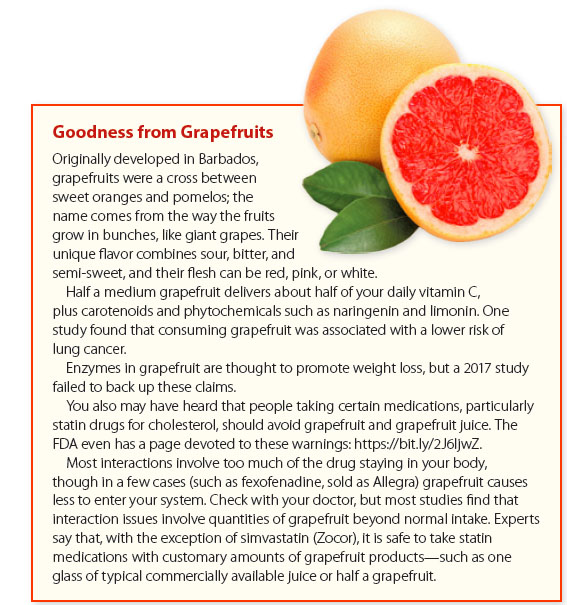Choose Scrumptious Citrus Fruits
The health benefits of citrus come in more than two-dozen tasty varieties, from oranges and lemons to exotic rangpur and yuzu. Amazingly, all were hybridized over the centuries from just three precursors—mandarin, pomelo, and citron. That common origin means the nutritional profiles of citrus are broadly similar, so you can choose whichever you like best.
“Citrus fruits are high in many micronutrients, but chiefly vitamin C, which is an antioxidant,” says Rachel Lustgarten, a registered dietitian nutritionist with Weill Cornell Medicine. “Citrus fruits also are good sources of fiber and are low in calories.” They also are modest sources of B vitamins, potassium, phosphorus, magnesium, and copper.
Vitamin C is vital to the formation of collagen, a primary component of the body’s connective tissue and essential for ligaments and tendons, wound healing and tissue repair, healthy skin and blood vessels. Vitamin C may help protect against cardiovascular disease, possibly by inhibiting oxidized LDL (“bad”) cholesterol. High levels of vitamin C help lower risk of cataracts.

Don’t count on vitamin C to keep you from catching the common cold. However, some studies do suggest it might reduce the length and severity of symptoms.
Fiber Facts
The fiber in citrus is mostly soluble, the type that helps improve cholesterol levels. One cup of orange slices contains 4 grams of fiber. However, fiber is lost in juicing.
“Eating a whole orange is ideal for getting the full nutrient load of the fruit—not just the strained juice, which has a high concentration of natural sugar,” Lustgarten explains. “Eating an orange in its whole form has the benefit of the water and fiber—both of which contribute to the feeling of satiety, or fullness, when we eat.”
One study that examined eating habits and weight changes over 24 years reported that citrus fruits were among foods linked to weight loss. A medium orange packs only about 60 calories, while half a grapefruit has about 50. A tablespoon of lemon juice has just four calories.
Phytonutrient Benefits
In addition to familiar nutrients such as vitamin C and fiber, citrus fruits contain more than 60 types of phytonutrient compounds, including flavonoids and carotenoids. These compounds have antioxidant and anti-inflammatory properties, for fighting free radicals and protecting cells. Hesperidin and apigenin, flavonoids found in citrus, have been studied for benefits to brain cells and function. Limonoids, another type of phytonutrient, have been studied for cholesterol-lowering benefits and anticancer properties. Polymethoxylated flavones, found in citrus peel, lower unhealthy cholesterol levels in laboratory animals.
Beta-cryptoxanthin, a carotenoid that helps give oranges their distinctive color, has been associated with a reduced risk of lung cancer. Other studies have linked citrus consumption to lower incidence of esophageal, stomach, breast, and pancreatic cancers. Zeaxanthin, another carotenoid, may be beneficial against rheumatoid arthritis. Mandarins, oranges, and grapefruit have the highest flavonoid content of all citrus fruits, while lemons have the lowest.
Whatever type of fruit you prefer, it’s simple to add more citrus to your diet. Says Lustgarten, “Citrus is easy to consume on the go, thanks to its thick skin, which acts as a naturally protective wrapper and makes it easy to carry. Also, keeping citrus fruits such as grapefruit, oranges, and clementines in a bowl on the kitchen counter can serve as a great reminder to grab one as a snack. Citrus fruits also make great garnishes to salads or marinades, as well as a way to add gentle flavor to cold tap water.”
The post Choose Scrumptious Citrus Fruits appeared first on University Health News.


